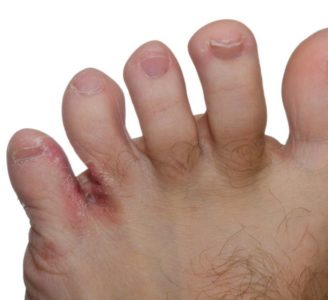 Athlete’s Foot is a skin condition categorized by fungus growth on the foot, generally occurring between the toes. The ideal spot for fungus to grow is in warm, dark places, so it’s easy to see why a foot, which is often tucked away in a tight shoe, is the perfect spot. Today, we take a closer look at why this condition develops, what symptoms are presented, and what you can to to treat and prevent Athlete’s Foot.
Athlete’s Foot is a skin condition categorized by fungus growth on the foot, generally occurring between the toes. The ideal spot for fungus to grow is in warm, dark places, so it’s easy to see why a foot, which is often tucked away in a tight shoe, is the perfect spot. Today, we take a closer look at why this condition develops, what symptoms are presented, and what you can to to treat and prevent Athlete’s Foot.
Athlete’s Foot Causes and Symptoms
Although it is more common in athletes because moisture can develop in the area when you sweat, you don’t need to be an avid sports enthusiast to develop Athlete’s Foot. Fungi can transfer onto your feet and grow if you go barefoot in high trafficked areas, especially warm and wet areas. Swimming pools, community showers and locker rooms are all breeding grounds for fungus, so take extra precautions if you frequent these places.
Symptoms of Athlete’s Foot include:
- Redness
- Dry or scaling skin
- An itchy or burning sensation
- Tenderness or inflammation
- Blisters or cracking of the skin
Despite it’s moniker, Athlete’s Foot isn’t always contained on the foot. The vast majority of cases develop on a person’s feet, but other warm, dark areas are also susceptible to fungi growth, like your armpits and groin.
Treatment and Prevention Of Athlete’s Foot
Prevention and treatment techniques are very similar, although you will need to take a couple of additional steps if certain at-home remedies fail to provide you with relief. The best way to prevent Athlete’s Foot from developing is by keeping your feet clean. Wash your feet with soap every time you’re showering in a shared location, and consider these other prevention techniques:
- Keep your feet dry, as moisture aids in the development of Athlete’s Foot.
- Along the same point, change your socks regularly.
- Consider investing in sandals or waterproof footwear if you use a community shower like in a dorm or locker room.
- Place newspaper inside your athletic shoes when not in use to ensure they are dry the next time you wear them.
- Use talcum powder on your feet to keep them dryer.
If you’ve tried the above techniques and you’re still experiencing symptoms after two weeks, head in to a foot specialist. They’ll be able to diagnose your condition and give you some other treatment options. They may prescribe fungicidal chemicals, topical creams or oral antifungal medications to take care of the growth. You may also be prescribed antibiotics if it is determined that the infection is being caused by bacteria. Medications typically have high rates of success in treatment, but they should also be paired with good foot hygiene and the above prevention tips to ensure a full recovery.